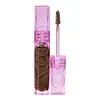What's inside
What's inside
 Key Ingredients
Key Ingredients

No key ingredients
 Benefits
Benefits

 Concerns
Concerns

 Ingredients Side-by-side
Ingredients Side-by-side

Water
Skin ConditioningCopernicia Cerifera Wax
Euphorbia Cerifera Wax
Ricinus Communis Seed Oil
MaskingPullulan
Stearic Acid
CleansingCetyl Alcohol
EmollientGlycerin
HumectantOleic/Linoleic/Linolenic Polyglycerides
EmollientSorbitol
HumectantGlyceryl Oleate
EmollientSilica
AbrasiveMica
Cosmetic ColorantPanthenol
Skin ConditioningBiotinoyl Tripeptide-1
Butyrospermum Parkii Butter
Skin ConditioningTocopherol
AntioxidantHelianthus Annuus Seed Oil
EmollientRosmarinus Officinalis Leaf Oil
MaskingFoeniculum Vulgare Fruit Oil
PerfumingTrehalose
HumectantAcacia Senegal Gum
MaskingPolylactic Acid
AbrasiveCitric Acid
BufferingXanthan Gum
EmulsifyingSodium Hydroxide
BufferingPhenethyl Alcohol
MaskingPentylene Glycol
Skin ConditioningPropanediol
SolventTin Oxide
AbrasiveCI 77891
Cosmetic ColorantCI 77492
Cosmetic ColorantCI 77491
Cosmetic ColorantCI 77499
Cosmetic ColorantWater, Copernicia Cerifera Wax, Euphorbia Cerifera Wax, Ricinus Communis Seed Oil, Pullulan, Stearic Acid, Cetyl Alcohol, Glycerin, Oleic/Linoleic/Linolenic Polyglycerides, Sorbitol, Glyceryl Oleate, Silica, Mica, Panthenol, Biotinoyl Tripeptide-1, Butyrospermum Parkii Butter, Tocopherol, Helianthus Annuus Seed Oil, Rosmarinus Officinalis Leaf Oil, Foeniculum Vulgare Fruit Oil, Trehalose, Acacia Senegal Gum, Polylactic Acid, Citric Acid, Xanthan Gum, Sodium Hydroxide, Phenethyl Alcohol, Pentylene Glycol, Propanediol, Tin Oxide, CI 77891, CI 77492, CI 77491, CI 77499
Water
Skin ConditioningAcrylates/Ethylhexyl Acrylate Copolymer
Synthetic Beeswax
Emulsion StabilisingVp/Hexadecene Copolymer
Acrylates/Octylacrylamide Copolymer
Palmitic Acid
EmollientGlyceryl Stearate
EmollientButylene Glycol
HumectantCellulose
AbsorbentCandelilla Cera
EmollientStearic Acid
CleansingAminomethyl Propanol
BufferingGlyceryl Distearate
EmollientCaprylyl Glycol
EmollientTetrasodium Glutamate Diacetate
Laureth-21
CleansingTristearin
Skin ConditioningEthylhexylglycerin
Skin ConditioningPolybutene
Sorbic Acid
PreservativeSodium Dehydroacetate
PreservativePhenoxyethanol
PreservativeMica
Cosmetic ColorantCI 77491
Cosmetic ColorantCI 77492
Cosmetic ColorantCI 77499
Cosmetic ColorantCI 77891
Cosmetic ColorantWater, Acrylates/Ethylhexyl Acrylate Copolymer, Synthetic Beeswax, Vp/Hexadecene Copolymer, Acrylates/Octylacrylamide Copolymer, Palmitic Acid, Glyceryl Stearate, Butylene Glycol, Cellulose, Candelilla Cera, Stearic Acid, Aminomethyl Propanol, Glyceryl Distearate, Caprylyl Glycol, Tetrasodium Glutamate Diacetate, Laureth-21, Tristearin, Ethylhexylglycerin, Polybutene, Sorbic Acid, Sodium Dehydroacetate, Phenoxyethanol, Mica, CI 77491, CI 77492, CI 77499, CI 77891
 Reviews
Reviews

Ingredients Explained
These ingredients are found in both products.
Ingredients higher up in an ingredient list are typically present in a larger amount.
Ci 77491 is also hydrated iron III oxide. It's sole purpose is to give a red/pink hue to products.
Iron III oxides are classified as inorganic chemicals for coloring.
Synthetically created Ci 77491 is considered safer than those naturally found. This is because the synthetically created version may contain less impurities. Iron oxides are generally non-toxic and non-allergenic.
Learn more about CI 77491Ci 77492 is also hydrated iron III oxide. It's sole purpose is to give a yellow hue to products.
Iron III oxides are classified as inorganic chemicals for coloring.
Synthetically created Ci 77492 is considered safer than those naturally found. This is because the synthetically created version may contain less impurities. Iron oxides are generally non-toxic and non-allergenic.
Learn more about CI 77492Ci 77499 is also hydrated iron III oxide. It is created from mixing red and black iron oxides. This helps give shades of darkness to a product.
Iron III oxides are classified as inorganic chemicals for coloring.
Ci 77891 is a white pigment from Titanium dioxide. It is naturally found in minerals such as rutile and ilmenite.
It's main function is to add a white color to cosmetics. It can also be mixed with other colors to create different shades.
Ci 77891 is commonly found in sunscreens due to its ability to block UV rays.
Learn more about CI 77891Mica is a naturally occurring mineral used to add shimmer and color in cosmetics. It can also help improve the texture of a product or give it an opaque, white/silver color.
Serecite is the name for very fine but ragged grains of mica.
This ingredient is often coated with metal oxides like titanium dioxide. Trace amounts of heavy metals may be found in mica, but these metals are not harmful in our personal products.
Mica has been used since prehistoric times throughout the world. Ancient Egyptian, Indian, Greek, Roman, Aztec, and Chinese civilizations have used mica.
Learn more about MicaStearic Acid is a fatty acid. It is an emollient, emulsifier, and texture enhancer.
As an emollient, stearic acid helps soften skin. It aids the skin's protective barrier by preventing water loss. It also provides a gentle cleansing effect without stripping away natural oils.
Stearic acid may also be used to enhance the texture of products. It can add volume and stabilize ingredients such as water and oil. This can help water and oil ingredients from separating.
Sources of stearic acid include animal or vegetable fats/oils such as coconut or shea. It can be naturally found in butter, cocoa butter, shea butter, vegetable fats, and animal tallow.
This ingredient may not be Malassezia folliculitis, or fungal-acne safe.
Learn more about Stearic AcidWater. It's the most common cosmetic ingredient of all. You'll usually see it at the top of ingredient lists, meaning that it makes up the largest part of the product.
So why is it so popular? Water most often acts as a solvent - this means that it helps dissolve other ingredients into the formulation.
You'll also recognize water as that liquid we all need to stay alive. If you see this, drink a glass of water. Stay hydrated!
Learn more about Water